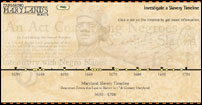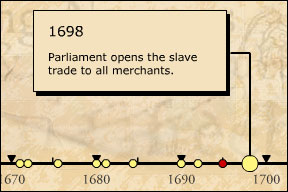
Investigate a Slavery Timeline
http://mdroots.thinkport.org/interactives/slaverytimeline/
As the Maryland colony grew, farmers discovered that selling tobacco to England was a good way to make money. It took a lot of land and people to grow tobacco. The colonists had plenty of land. However, there were not always enough workers.
Farmers had tried to use several different kinds of workers. They signed contracts with indentured servants from England. They enslaved Native Americans and Africans to do this hard work. For many reasons, the colonists ended up relying on African slaves.
Landowners felt it was all right to use Africans as slaves in Maryland because the Africans were "different." They had different skin color and hair texture. They spoke different languages than English. They worshipped a different god. And, since they were far away from their homes, Africans had nowhere to go and no one to protect them. African slaves did a great deal of things for the colonists. They cleared forests and trapped animals. They built things, and took care of children. But in Maryland, their most important job was to work on tobacco farms.
Even though Africans helped the colony succeed, they had very few rights. Some came to Maryland as indentured servants, but most arrived as slaves. Maryland wrote new laws that treated African slaves differently from everyone else in the colony. These laws slowly took away their rights. Many laws were based on the color of a colonist's skin. By the end of the 17th century, all Africans were slaves for life.
Read more about the history of slavery in Early Maryland and how this unjust condition came about from historian David Taft Terry.
How Do We Know About Slavery in 17th Century Maryland?
By looking at the laws and court proceedings from 17th century Maryland, we can learn about the daily life of slaves and others in Maryland. These Primary Source Documents offer important clues and data to help us understand the important events that contributed to Maryland's history of slavery. The Maryland State Archives is one of the best resources for exploring these primary source documents.
How to Use the Maryland Slavery Timeline
  Left (Rollovers) - The larger dot (mouse rollover) displays year with related event. Right (Image) - Displayed Image for 1698 (Slave Trade) By clicking on a dot, a display window appears with more detailed information and related image. |
As you scroll through the dates, you'll see clickable dots and slavery facts on the timeline. Click on each dot to learn more about the event and why it was important. Be sure to follow the links you'll see on the pop-up pages. They take you to primary source documents related to that event.
Most of the documents you will read are records of court trials and actions by the colonial government. They are written in the language of time. This language is different from the English we speak today.
Here are a few tips to help you understand what they mean.
-
At the top of the document you will see its title, date, and page number. You might see, for example:
Assembly Proceedings, September 1664. 533
or
Provincial Court Proceedings, 1676. 291
You would be looking at:
The actions taken by the Assembly during September 1664, on page 533 of these records.
or
Reports from the actions of the Provincial Court in 1676, on page 291 of these records.
- Check the glossary of historical terms if you find a word you don't understand. Try it now by looking up definition of the word "liber."
- You may see words and abbreviations such as Liber C&WH, Liber P. C. R., and U.H. Journal 1659-69, in the margins of legal and court documents. These refer to the paper copies of the information. The Archives placed these on line in a digital format.
- As you read the unfamiliar language in the documents, try to guess what some of the strange spellings and abbreviations mean. For example, what do you think "servt." and "psons" mean? If you guessed "servant" and "persons," you're right! Reading the laws and court cases may take some time, but you'll get the hang of it. You'll also get an eyewitness account of life in Early Maryland.
© 2025 Maryland Public Television. All Rights Reserved.